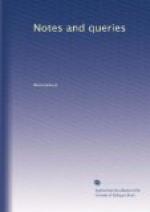“Wrusum or Wursum.”—The latter is the correct reading. Trotter Brockett includes the word amongst Northern Provincialisms.—“Wursum, pus, particularly when foul.” Jamieson is inclined to derive the word woursom or worsum, used in the same sense by Douglas, in his translation of Virgil, and by other North Country writers, from Ang.-S. Wyr, pus, and sum, as denoting quality.
“Sabraz.”—This term has perplexed me much in preparing notes on the portion of the Promptorium I have now in hand. In the Harl. MS. 221. is found “Sabrace, sabracia, Comm.” The authority cited, the Commentarius Curialium, is still unknown to me; and I have failed in searching for the word sabracia, which is not found in Ducange, or other glossaries of debased Latinity. Mr. Halliwell gives “Sabras, salve, plaster;” but he cites no authority. It appears, however, rather to signify a tonic or astringent solution than a salve. I have hitherto found it only in the following passage (Sloane MS. 73., f. 211., late xv. sec.) in a recipe for making “cheuerel lether of perchemyne.” The directions are, that it be “basked to and fro” in a hot solution of “alome roche;—aftir take xelkis of eyren and breke hem smale in a disch, as thou woldist make therof a caudel, and put these to thyn alome water, and chaufe it; thanne take it doun fro the fier, and put it in the cornetrey; thanne tak thi lether and basche it wel in this sabras, to it be wel drunken up into the lether.” A little flour is then to be added, the mixture heated, and the “perchemyn well basked therein, and th’t that saberas be wel drunken up into the lether;” and if it enters not well into the leather, “lay it abroad in a good long vessel that be scheld, the fleschside upward, and poure thi sabrace al abouen the lether, and rubbe it wel yn.” It is further recommended to “late the lether ligge so still al a nyzt in his owen sabras.”
“I-menbred, a girdle i-menbred.” (Thus, in old French, “menbrer, membrer,” &c., Roquefort). Charpentier gives similar use of the Latin word,—“Membrare, instruere, ornare, Gall. garnir;” citing a French document, dated 1352: “Item, unam zonam de serico Membratam de argento et esmandis;” and another of 1366: “Duas zonas de serico, argento stofatas et Membratas.” The term was thus used also in England, as in the inventory of valuables belonging to Edward I. in 1300 (Liber Garderobae, p. 347.):—“Una zona, cum cathenis argenti annell’ cum targ’ et membris argenti.” It might be supposed from this expression, that the membra were, strictly speaking, the transverse bars of metals, or cloux, Fr., by which the girdle was divided into several compartments, the intervening spaces being filled by chased ornaments of goldsmiths’ work, and occasionally by armorial scutcheons, “targie.”
But enough for the present. I should esteem it a favour if your correspondent would inform me where these curious terms are found, as the context would greatly facilitate their elucidation.




